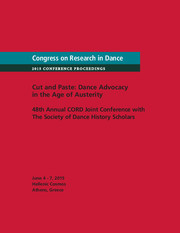No CrossRef data available.
Article contents
Contemporary Dance at University: A Vessel for Creative Engagement with Learning
Published online by Cambridge University Press: 04 January 2013
Abstract
Guiding dancers toward embodied experience, full engagement with their own physicality, awareness, and intention have been constant aims of my teaching over the course of forty years. Do students in the university program where I now teach “get it”? With a current technique class, I have investigated—through journaling and discussion—students' expectations around the “power structure” of dance class, how they perceive their sense of responsibility to their own training, and whether and how they evolve in making passionate choices and engaging deeply with dancing (albeit somewhat subversively) within the academic setting.
- Type
- Panel: A Dance of Empowerment: Teaching Dance at the Post-Secondary Level
- Information
- Copyright
- Copyright © The Author(s) 2009


